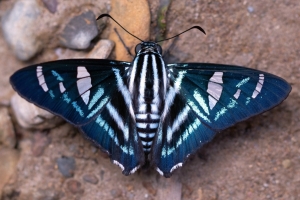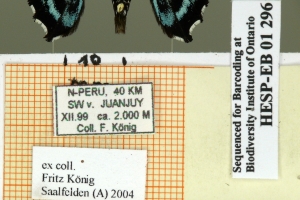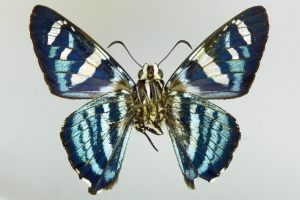Version 7 (neueste) vom 20. Juli 2024 um 17:46:51 von Michel Kettner
Länder:

 +8Kontinente:KISA
+8Kontinente:KISA


 +8Kontinente:KISA
+8Kontinente:KISAInhalt
2. Diagnose
2.1. Männchen
1-3: ♂, Daten siehe Etiketten (coll., det. & fot.: Ernst Brockmann, Fotos bearbeitet: Michel Kettner)
4-6: Holotypus ♂, Daten siehe Etiketten (fot.: Nick V. Grishin, Fotos bearbeitet: Michel Kettner), © Images copyright Trustees Natural History Museum, used with permission.
2.2. Weibchen
1-3: ♀, Daten siehe Etiketten (fot.: Ernst Brockmann, Fotos bearbeitet: Michel Kettner), coll. Departamento de Zoologia, Universidade Federal do Paraná, Curitiba, Paraná, Brazil. Dieser Falter wurde ursprünglich als Paratype von Elbella madeira bestimmt. Erst nach der DNA-Untersuchung wurde Blubella etna festgestellt.
3. Weitere Informationen
3.1. Andere Kombinationen
- Elbella etna Evans, 1951 [Originalkombination]
3.2. Synonyme
- Elbella etna moda Evans, 1951
3.3. Faunistik
Nach Mielke, Brockmann & Mielke (2022) kommt die Art in Kolumbien, Ecuador, Peru, Bolivien, Trinidad und Tobago, Französisch-Guayana, Brasilien und Argentinien vor.
Locus typicus: Brasilien.
(Autor: Michel Kettner)
3.4. Literatur
- Brockmann E., Mielke, C. G. C. & O. H. H. Mielke (2022): Hesperiidae III: New World Pyrrhopyginae, short text and plates. — In: E. Bauer & T. Frankenbach (ed.) (2022): Butterflies of the World 50: 40 p. + 76 pl. Keltern.
- Erstbeschreibung: Evans, W. H. (1951): A Catalogue of the American Hesperiidae indicating the classification and nomenclature adopted in the British Museum (Natural History). Part I. Introduction and Group A Pyrrhopyginae: i-x, 1-92, pl. 1-9. — Digitalisat auf biodiversitylibrary.org: [46], [pl. 5]
- Mielke, O. H. H., Brockmann, E. & C. G. C. Mielke (2022): Hesperiidae II: New World Pyrrhopyginae, detailed text. — In: E. Bauer & T. Frankenbach (ed.) (2022): Butterflies of the World 49: 120 pp. Keltern.
- Orellana A. (2008): Pyrrhopyginae de Venezuela (Lepidoptera: Hesperioidea: Hesperiidae). — Entomotropica 23 (3): 177-291. [PDF auf saber.ucv.ve]
3.5. Informationen auf anderen Websites (externe Links)
- [Global Biodiversity Information Facility], dort unter Elbella etna zu finden.



















